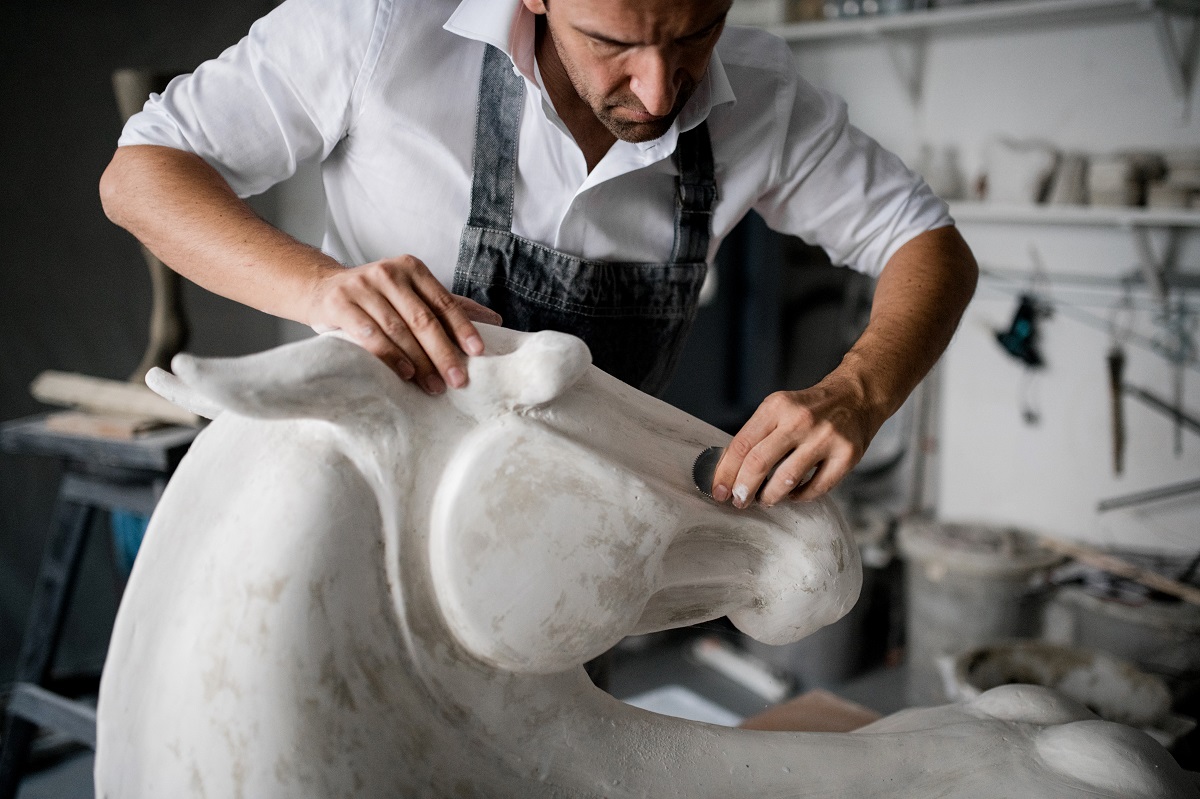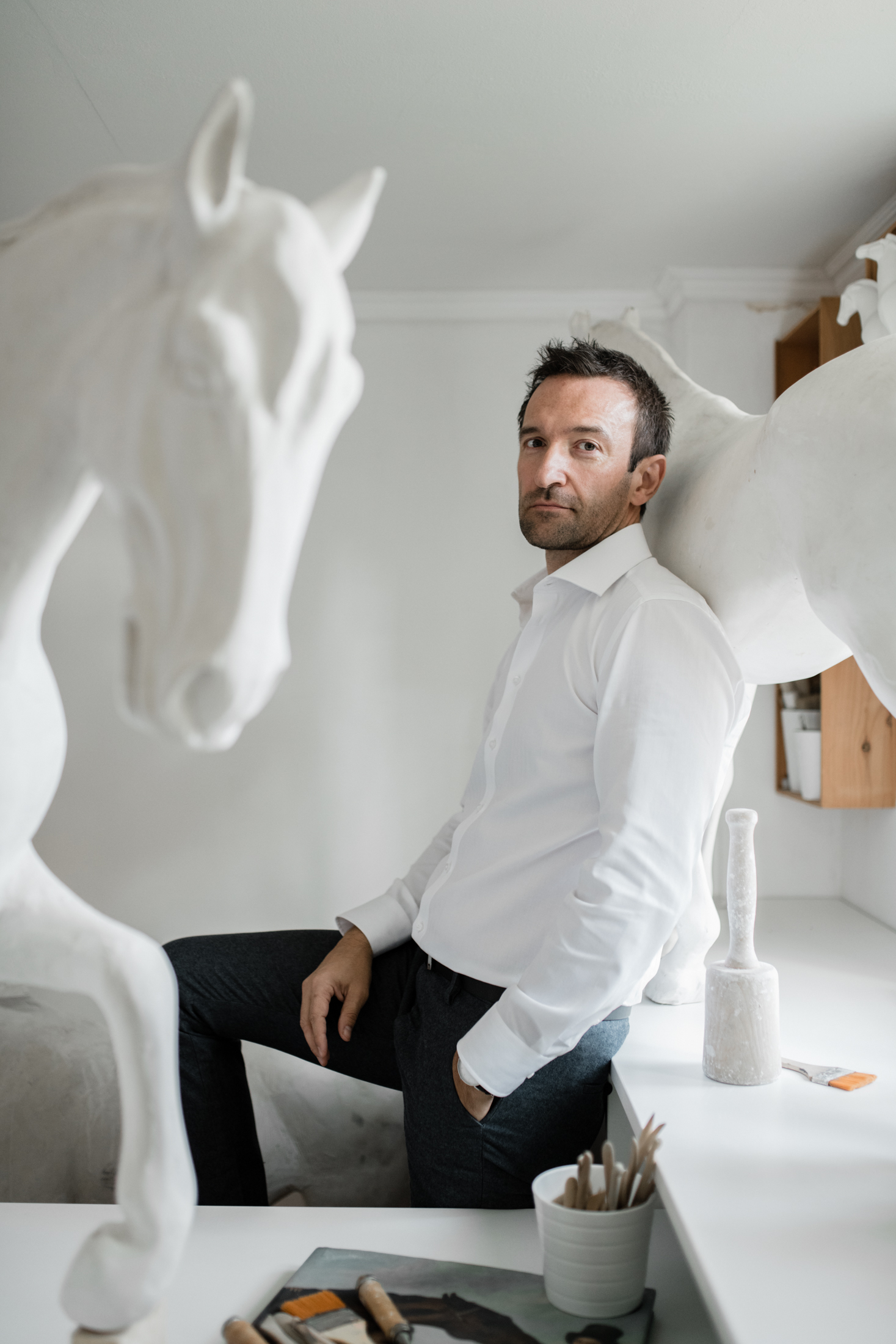During the isolation, I made a relief that I named Pangea, after the so-called supercontinent where all the continents we know today were merged into one. With my overall action during the pandemic, I wanted to emphasize the importance of connectivity versus physical separation.

The famous sculptor Hrvoje Dumančić is currently preparing two exhibitions, and he recently reopened his studio to the public whose direct contact with art opens up space for revitalization after the experience with the coronavirus and the earthquake. Although he was extremely active online, our interlocutor says that he is immensely looking forward to the exhibitions in July and September. “Although I am active and present virtually, in my soul I am an analogue type and I always give preference to personal, physical and verbal communication,” says Dumančić.
What did the period of corona mean for you as an artist?
The artistic vocation is often solitary in itself, so isolation in the time of coronavirus has not significantly changed the usual way I act and function as an artist. For many artists, such isolation from the outside world is also necessary for artistic creation. However, at the time of isolation, I was permeated by strange feelings that prompted me to further contemplation and encouraged me to create several new works at that time, which were in some way related to the situation in which we found ourselves. This is how a series of reliefs was created, and I named one of them Pangea, after the so-called supercontinent in which the continents as we know them today were merged into one. It was with this relief that I wanted to emphasize that we are all connected regardless of the physical separation. The predictions that the continents could be reunited in the future are interesting. Also, I was surprised that in the current fast-paced lifestyle, something so invisible can seemingly stop the world. The earthquake in Zagreb further created even greater uncertainty. It all affected all of us, and everyone dealt with the situation in their own way.
It is incentive and nice to see the people connecting and becoming a support to each other. Likewise, the solidarity of the people at the time of the earthquake that struck Zagreb along with coronavirus again shows the values that we need to nurture and emphasize. I have a feeling that at that time, at least temporarily, the trivial, shallow contents that have become the everyday life of today’s consumer society have disappeared. I saw that people started noticing even the small things that might not caught their attention before… like the chirping of birds, clean air and clear skies.
Over the past years, you have opened your studio to the people interested in artwork and to tourists who respect your art. Do you miss that audience presence in your life today?
Ever since I moved to a new studio downtown, I’ve wanted to bring those interested even closer to what I’m doing. Usually people have the opportunity to visit galleries and museums and view finished works, without contact with the artist, but a different dimension is created this way, a much more personal and complete picture than people can experience through social networks. People are also encouraged to be creative personally through the opportunity to participate in sculptural workshops that I occasionally organize in the studio. Despite this situation, as soon as the opportunity appeared for organization of sculptural workshops during this epidemic, increasingly more people are showing interest in them. I think that revitalization through some creative content is necessary, especially after the isolation.

Art was with us during the corona through numerous social media. Were the sculptors, whose art is not a theatre play or a movie, somewhat pushed outside the audience’s focus or not?
That depends, everything moved to digital media and social networks. Those who used them before were maybe just even more active or they came up with some new content. Some artists were forced to change their usual actions due to the situation, so they decided to set up their own accounts during the coronavirus, just like the majority of galleries and museums organized online exhibitions. I also posted the creation process in the studio through live videos and stories, and I was glad to get positive feedback. It was important for me to send the message that this situation must not close us completely, that we need to find a way to stay connected, creative and originative, even if online.
What preoccupies you today in contemplation about your specific artistic focus? Do horses still remain your focus or do you plan to focus on something else? And why horses?
Horses have been my inspiration since childhood, and they also became a part of my identity through artistic activity. I’m not one to run away from changes and some other motives; it’s just that I’m still happy to create stories where I use the horse’s body that serves me as a medium. Horses marked my life, my growing up, and they are still a part of my everyday life today. I have answered countless times to the question of why horses and countless answers can be given, but in short I think each of us has something that carries them through life, that moves them, and when you discover it, you find and feel that feeling is part of you, within you, it is a sufficient sign that you are on the right path and that you just need to keep following it and discover where it will take you. To me, horses were a great signpost in life, teachers who did not speak the language spoken by humans, but they connected me to our primordial link to nature, freedom, strength and sensibility.
You are spiritually (Your connection is well known) connected to France. How did you maintain contact during this time with the country, the people, and the collectors who first recognized your talent?
Well I can say that I did, because my artistic affirmation started precisely from France exactly 20 years ago, and through those years I made business and private contacts, as well as closeness to the country and people who were the wind in my back as a young artist. This year I had an agreed visit and organization of sculptural workshops that were supposed to start in France, but unfortunately we had to postpone everything. I keep in touch as before through social networks, video calls, and a novelty during the corona were the Zoom meetings. Personally, I was touched by the reaction and support of close friends from France after the earthquake in Zagreb.
Artists everywhere have been and still are existentially affected by the coronavirus. How do you find ways to keep in touch with your audience in this virtual time?
This is a challenging time for us all, not only for the artists, merely a few profit precisely from this situation, most of them are faced with great challenges and uncertainty about what the situation will transform into. For the first two months, I stopped all my activities and tried to be mentally and physically strong, to be supportive of my loved ones and compassionate with everyone else. I tried to be active through social networks, I sent some a piece of clay to model with children or family, or friends at home and relax a bit, and waited for everything to stabilize a bit. I am currently preparing two exhibitions, one in July and the other hopefully in September. Although I am active and present virtually, in my soul I am an analogue type and I always give preference to personal, physical and verbal communication.
You have been using digital technology in your work for a long time. How much can this technology help the artist and where does its effect end?
Digital technology imposes itself on us and it doesn’t leave us lots of options, it’s take it or leave it. For me personally, digital technology has both positive and negative aspects, and it’s up to us to what extent and how we use it. It gives us the opportunity for global visibility, to create our own audience and promote the values we advocate. On the other hand, this freedom of digital media and the diversity of content is an indicator of the society we are in, and while once editors of magazines, shows, curators, fashion designers imposed trends, today it is much more transparent and leaves it up to the individual to create content to follow and to ennoble his life in a way that suits him.